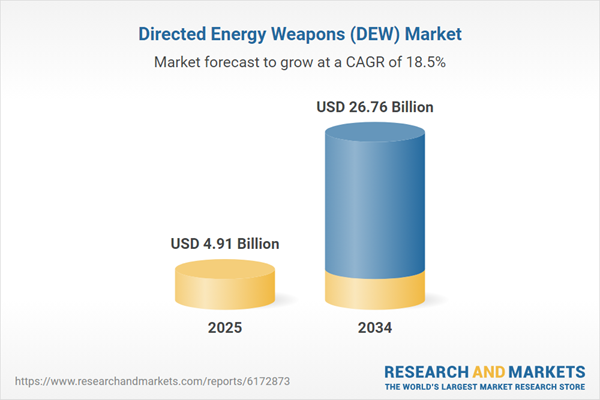North America and Asia-Pacific to be Significant Regional Markets for Directed Energy Weapons (DEW)
North America is one of the leading regions dominating the global directed energy weapons (DEW) market. At the same time, the Asia-Pacific is expected to be the fastest-growing market over the forecast period. Due to the leading investment in the defence and homeland security budgets in North America, especially in the United States, higher development in the information technology and microelectronics industry is expected to fuel the regional market growth.The region also dominates the market due to the robust investment of the United States Department of Defence (DoD) to integrate the directed energy weapon technology into the army, navy, and air force. Organisations like the Air Force Research Laboratory (DARPA), Pentagon, the United States Army Armament Research Development and Engineering Centre, and others are involved in the development of directed energy weapons which is further boosting the market growth.
China is the primary market player in the Asia-Pacific, whereas the market in India is under development. Due to rapid economic expansion and rising security challenges across the Asia-Pacific region, and an increase in border conflicts, demand for directed energy weapons has increased in recent years. Due to the increasing likelihood of being targeted by terrorist attacks, China, Japan, and India have increased their military spending in recent years. China is expected to be a significant area over the forecast period owing to anti-laser defence developments. India’s research organisation Defence Research and Development Organisation (DRDO) has planned high powered laser weapons technology development. Additionally, rapid economic growth and development continue to fuel the defence budget, expanding the Asia-Pacific military sector and influencing defence and homeland security applications in the region.
Directed Energy Weapons (DEW): Market Segmentation
Directed energy refers to a technology that produces a beam of concentrated electromagnetic energy, including radio waves, microwaves, lasers, among others. Weapons with this technology are commonly utilised to disable, damage, or destroy hostile equipment, facilities, and personnel. High-energy laser weapons, high-power radio frequency or microwave devices, and charged or neutral particle beam weapons are all typical product types. These weapons have several advantages over traditional munitions, including as high-speed fatal force transfer, minimum effects of gravity or atmospheric drag, stealth-like performance with noise-free and invisible beams, among others. As a result, directed energy weapons are found in a wide range of military ships, land vehicles, aircraft, and unmanned vehicles (UMVs).By product type, the industry is divided into:
- Lethal
- Non- Lethal
On the basis technology, the market is segmented into:
- High Energy Laser
- High Power Microwave
- Particle Beam
- Others
Based on application, the directed energy weapons (DEW) market is divided into:
- Homeland Security
- Defence
The end-use of the market are as follows:
- Airborne
- Gunshot
- Land Vehicles
- Ship Based
The regional markets for directed energy weapons (DEW) industry can be divided into:
- North America
- Europe
- Asia-Pacific
- Latin America
- Middle East and Africa
Rising Modernisation and Investments in Military Platforms Boosting the Market Growth
The rising focus of defence forces across the globe on modernising their military electronic warfare and defence systems, increasing investments being made by respective governing bodies towards military aid, including directed energy weapon systems, will propel the market growth of directed energy weapons. The market is expected to grow on account of increasing lethal and precise weapons demand over the forecast period. Defence is expected to be a major directed energy weapons consumer. Over the projected period, the global market is expected to be driven by the changing nature of conflict in the global environment. Furthermore, focused energy weapons can cause minimal collateral harm to the target. This factor is expected to boost global demand. Other features such as efficiency against fast-moving objects, numerous target area coverages, infinite magazine, long-range, and precision aiming are expected to positively impact the global market. In the future years, rising protests, unrest, political disputes, and conflicts are projected to boost worldwide demand. Other factors driving the worldwide directed energy weapons market are the need to defend against terrorist attacks, chemical, biological, radiological, and nuclear materials to protect civilian lives and a country's national security. Lasers, high-power microwaves, and electromagnetic weapons are being utilised to protect against threats such as ballistic missiles, anti-satellite weapons, and nuclear weapons, among others, which is projected to fuel the market's expansion.Key Industry Players in the Global Directed Energy Weapons (DEW) Market
The report gives a detailed analysis of the following key players in the global directed energy weapons (DEW) market, covering their competitive landscape, capacity, and latest developments like mergers, acquisitions, and investments, expansions of capacity, and plant turnarounds:- Roketsan Roket Sanayii ve Ticaret A.S.
- Applied Companies Corporation
- BAE Systems plc
- Lockheed Martin Corporation
- The Boeing Company
- Raytheon Technologies Corporation
- Others
Table of Contents
Companies Mentioned
The key companies featured in this Directed Energy Weapons (DEW) market report include:- Roketsan Roket Sanayii ve Ticaret A.S.
- Applied Companies Corporation
- BAE Systems plc
- Lockheed Martin Corporation
- The Boeing Company
- Raytheon Technologies Corporation
Table Information
| Report Attribute | Details |
|---|---|
| No. of Pages | 176 |
| Published | August 2025 |
| Forecast Period | 2025 - 2034 |
| Estimated Market Value ( USD | $ 4.91 Billion |
| Forecasted Market Value ( USD | $ 26.76 Billion |
| Compound Annual Growth Rate | 18.4% |
| Regions Covered | Global |
| No. of Companies Mentioned | 7 |









